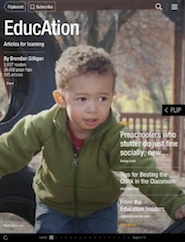Great article from Quartz Daily News – qz.com [Read the whole article here.]
“I’m just not a math person.”
We hear it all the time. And we’ve had enough. Because we believe that the idea of “math people” is the most self-destructive idea in America today. The truth is, you probably are a math person, and by thinking otherwise, you are possibly hamstringing your own career. Worse, you may be helping to perpetuate a pernicious myth that is harming underprivileged children—the myth of inborn genetic math ability.
Here are some summary points:
For high school math, inborn talent is just much less important than hard work, preparation, and self-confidence.
Again and again, we have seen the following pattern repeat itself:
- Different kids with different levels of preparation come into a math class. Some of these kids have parents who have drilled them on math from a young age, while others never had that kind of parental input.
- On the first few tests, the well-prepared kids get perfect scores, while the unprepared kids get only what they could figure out by winging it—maybe 80 or 85%, a solid B.
- The unprepared kids, not realizing that the top scorers were well-prepared, assume that genetic ability was what determined the performance differences. Deciding that they “just aren’t math people,” they don’t try hard in future classes, and fall further behind.
- The well-prepared kids, not realizing that the B students were simply unprepared, assume that they are “math people,” and work hard in the future, cementing their advantage.
Thus, people’s belief that math ability can’t change becomes a self-fulfilling prophecy.
The idea that math ability is mostly genetic is one dark facet of a larger fallacy that intelligence is mostly genetic. Academic psychology journals are well stocked with papers studying the world view that lies behind the kind of self-fulfilling prophecy we just described.
Convincing students that they could make themselves smarter by hard work led them to work harder and get higher grades. The intervention had the biggest effect for students who started out believing intelligence was genetic. (A control group, who were taught how memory works, showed no such gains.)
But improving grades was not the most dramatic effect, “Dweck reported that some of her tough junior high school boys were reduced to tears by the news that their intelligence was substantially under their control.” It is no picnic going through life believing you were born dumb—and are doomed to stay that way.
While American fourth and eighth graders score quite well in international math comparisons—beating countries like Germany, the UK and Sweden—our high-schoolers underperform those countries by a wide margin. This suggests that Americans’ native ability is just as good as anyone’s, but that we fail to capitalize on that ability through hard work. In response to the lackluster high school math performance, some influential voices in American education policy have suggested simply teaching less math—for example, Andrew Hacker has called for algebra to no longer be a requirement. The subtext, of course, is that large numbers of American kids are simply not born with the ability to solve for x.
One way to help Americans excel at math is to copy the approach of the Japanese, Chinese, and Koreans. In Intelligence and How to Get It, Nisbett describes how the educational systems of East Asian countries focus more on hard work than on inborn talent:
1. “Children in Japan go to school about 240 days a year, whereas children in the United States go to school about 180 days a year.”
2. “Japanese high school students of the 1980s studied 3 ½ hours a day, and that number is likely to be, if anything, higher today.”
3. “[The inhabitants of Japan and Korea] do not need to read this book to find out that intelligence and intellectual accomplishment are highly malleable. Confucius set that matter straight twenty-five hundred years ago.”
4. “When they do badly at something, [Japanese, Koreans, etc.] respond by working harder at it.”
5. “Persistence in the face of failure is very much part of the Asian tradition of self-improvement. And [people in those countries] are accustomed to criticism in the service of self-improvement in situations where Westerners avoid it or resent it.”
Besides cribbing a few tricks from the Japanese, we also have at least one American-style idea for making kids smarter: treat people who work hard at learning as heroes and role models. We already venerate sports heroes who make up for lack of talent through persistence and grit; why should our educational culture be any different?
Math education, we believe, is just the most glaring area of a slow and worrying shift. We see our country moving away from a culture of hard work toward a culture of belief in genetic determinism. In the debate between “nature vs. nurture,” a critical third element—personal perseverance and effort—seems to have been sidelined. We want to bring it back, and we think that math is the best place to start.
Read the whole article here.
Follow Miles on Twitter at @mileskimball. Follow Noah at @noahpinion. We welcome your comments at ideas@qz.com











